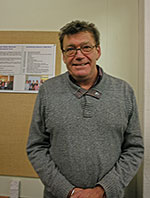
What is the future for the Otaki’s Stand Children’s Village, will they move away or will they stay? And a bigger question for Otaki people is what will become of the land and rotunda?
Chris Haddock, Stand Children’s Services regional manager, was the guest speaker at the June meeting of the Otaki Historical Society. Although he wasn’t able to answer many of the questions members hoped-for answers to about the future of the Children’s Health Camp, rebranded Stand for Children about three years ago, but he was able to speak of the changes and directions in care since the camp opened.
Many of the current buildings are in need of upgrading and are likened to institutions, the historic rotunda is in a serious state of disrepair — “the roof leaks, it’s falling down, estimated cost of repairs is in excess of $1 million and because it’s a heritage building we can’t touch it,” Mr Haddock said. The rotunda, built in the 1920’s as part of the Rotorua hospital, was moved to Otaki in the early 1930’s.
It was estimated it would cost as much to rebuild as to alter and upgrade the present buildings
With the changes in children’s care and needs a more “family” oriented building is being sought.
The seven Stand villages (formerly children’s health camps) receive funding from the Ministry of Social Development and the education ministry pays for the school and its teachers, but no one pays for the upkeep of the property.
But with the social changes over the years, some of the biggest changes are the needs of the children, who are now more likely to have been abused, neglected, have special needs, or are coping with trauma. Now only 22 children are accommodated for four to five weeks, instead of the 50–60 children who would come in for six weeks at a time.
“Today children are not in need of nourishment,” Mr Haddock said. “It’s not the physical needs of children, now it’s neuroscience – these children’s brains don’t develop as in children in caring homes do. Children living with grandparents come for respite care to give the carer a break. This is a happy place, the rules are simple.”
The first children’s health camp came about through an experimental children’s camp. By 1930’s the depression had set in and children’s specialist, Dr Elizabeth Gunn realised something needed to be done about children’s health, many were undernourished and in poor health. She set up her experimental camp — in tents — at Turakina and was impressed at the change in the children after a few weeks with three nutritious meals a day, regular routines and illness treated. This camp led to the current health camps.
In Otaki, entrepreneur and land owner, Byron Brown, gave the land for the children’s camp and the first camp buildings went up and remain there today.
“The Otaki area gave the children somewhere safe; a happy place they could go to,” said Barbara Scott, an Otaki-Te Horo resident for many years.
If or when the move comes, people want to know now what becomes of the beach property.
“I don’t believe the people of Otaki have been consulted about making the change for better, for the children,” Historical Society member, Ann Thorpe said.
The Society agreed that the Otaki Historical Society write a letter for Mr Haddock to take to the Stand regional managers meeting, to be held the following week.

